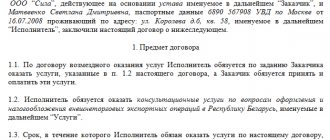Concluding cooperation agreements is an everyday practice in the work of business entities. If the terms of the agreement suit both parties, then there will be no problems with signing it. But it also happens that one of the parties, having examined the presented contractual draft, proposes to make certain adjustments to it.
Upon successful resolution of controversial issues that arose at the stage of signing the contract, changes (edits) approved and introduced by the parties are consolidated and documented in a separate document - a protocol of disagreements.
What is a dispute protocol?
If a party does not agree with some points of the agreement proposed by the other party for signing, it has the right to initiate the drawing up of a so-called protocol of disagreements.
This situation often arises, since business entities usually develop standard versions of cooperation agreements in pursuit of personal interests.
The party that proposes its own draft agreement for signing may include in it conditions that are not beneficial and suitable for the other party. The opposite party, which has discovered that the proposed agreement contains unfavorable parameters, has the right to reflect its claims in the protocol of disagreements.
The presence of a protocol of disagreements allows counterparties to clearly identify problematic issues - controversial points of the agreement that must be resolved before the start of the proposed cooperation.
The protocol of disagreements cannot be considered an independent document - it is usually considered as a direct component of the agreement itself, proposed by one of the counterparties for conclusion. It is drawn up before the signing of an agreement containing parameters that are controversial and contrary to the interests pursued by any of its parties.
In this case, the protocol should not be identified with an additional agreement concluded to the main agreement or with an annex to it:
- An additional agreement usually formalizes an adjustment to an existing contract.
- Attachments are often documents of a clarifying nature. These can be cost estimates, cost calculations, price justification, design and technical documentation, handover certificate.
- By drawing up a protocol of disagreements, an agreement that has not yet been signed by the parties is adjusted. Its goal is to resolve controversial issues found in the text of the agreement (that is, change certain parameters before signing).
In what cases is it compiled?
A protocol of disagreements is usually drawn up so as not to adjust the text in the agreement itself. The practice of compiling it is justified for the following reasons:
- The parties live quite far from each other (for example, in different cities). In such a situation, their meeting may be problematic.
- Discussing the parameters of the agreement being concluded through lengthy correspondence, lengthy telephone conversations or regular personal meetings is not practical, convenient or desirable.
- The parties (or one of the parties) do not want to redo the original version of the agreement. It is important to note that correcting the original text may lead to new errors. It is easier to reflect all necessary amendments in the protocol of disagreements to the contractual draft.
- The agreement provided for signing is public, and its content is regulated by the accounting policies of the party that offered to sign it. Without a protocol of disagreements, the terms of such an agreement cannot be changed.
Isolating disagreements in the form of a separate document allows you to adjust the terms of cooperation without changing the original text of the relevant agreement.
An important nuance is that such a document must be agreed upon and executed before the cooperation agreement is signed. At the same time, the parties save time, money and their own nerves, simplifying the procedure for resolving controversial issues at the stage of signing the terms.
How to sign up for a contract?
A generally binding unified template is not regulated by current legislation. This means that the parties have the right to draw up this document in a free (arbitrary) form.
It is recommended to include the following information:
- Information about business entities - parties. Their official names are indicated (names for legal entities or full names for individuals), as well as codes, registration addresses and other identifying information.
- The date of compilation, as well as its name and number in the document flow register of the business entity (party).
- Place of compilation (city).
- Details of the agreement in respect of which this protocol is drawn up. The number, as well as the date of its compilation, are indicated.
- The content part is a list of points to be adjusted. For each such item, you need to indicate not only the new interpretation (corrected version), but also its original version. In addition, the necessary notes may be indicated for the changed items. The content part is usually formatted as a table of three columns (graph) - a new, old version of the item, a corresponding note.
- Full names and positions of persons authorized to sign the protocol on behalf of their business entities.
- Signatures of the parties (authorized persons).
The agreed protocol of disagreements is signed by both parties and thereby acquires proper legal force, that is, it becomes a full-fledged and integral component of the main agreement.
In this case, the text of the main agreement must contain an indication that it is considered valid taking into account the corresponding addition.
The protocol is drawn up in two equivalent copies (each party to the agreement receives its own copy).
.
Sample for a supply agreement.
Sample for a lease agreement.
Compilation algorithm
So, let's look at the procedure for signing an agreement with a document aimed at resolving all comments:
- an analysis of the project received from the counterparty is carried out;
- controversial points are identified and documented comments are sent (it is necessary to reflect each comment and propose a different edition);
- if the counterparty agrees with the proposals, then its authorized representative signs the contract, and an act of settlement of these comments is drawn up.
In the event that the counterparty to the contract does not agree with the comments, it is necessary to negotiate to find a solution that will satisfy both parties and allow the signing of the contract. If the counterparty insists on the need to sign the initial version, then, in accordance with current legislation, the other party has the right to go to court with a demand to compel its conclusion.
The procedure for reconciling disagreements between the parties
Disagreements that arise regarding the terms (parameters, clauses) of the concluded agreement are agreed upon by the parties in the following order:
- The first party that received the contract for signing and discovered inappropriate (unfavorable) conditions in it, duly draws up the corresponding protocol of disagreements. She signs not only the protocol drawn up, but also the main agreement received. At the same time, she notes on the main agreement that it is valid taking into account the corresponding protocol of disagreements, and next to it indicates the date of its preparation. The presence of such a mark will protect the party in case of litigation. The signed documents are sent to the party that proposed the main document for signing.
- The second party receives the signed documents, puts their signatures on them (if there are no objections) and sends the signed copies to the other party. In this case, the parties are considered to have reached agreement.
- If the party that proposed the agreement for signing did not agree with the disagreements received, it has the right to draw up a protocol of settlement (approval) and send it to the other party. This situation could lead to a delay in the process of reaching agreements. There are two possible ways out of it - either a new version of the main agreement is drawn up, or the parties refuse to cooperate altogether.
In order not to delay the procedure for reaching agreements, the protocol of disagreements should indicate a specific period during which the opposite party is obliged to respond to receiving information.
This is an important recommendation, since the period for signing disagreements is not regulated by law. An exception is defined by Article 445 of the Civil Code of the Russian Federation for those situations when the party that received or sent the offer is obliged to conclude an appropriate agreement (this norm establishes a thirty-day period for sending disagreements or for responding to the received protocol).
The agreement was signed with a protocol of disagreements: important conditions
According to paragraph 1 of Art. 432 of the Civil Code of the Russian Federation, a transaction is considered concluded from the moment the participants agree on all essential conditions and formalize them in the proper form. The following conditions are considered essential:
- about the subject of the transaction;
- named in regulations as essential for this type of transaction;
- declared as such by any of the participants.
IMPORTANT! Until the protocol of disagreements containing essential terms is signed, the transaction is considered unconcluded (except in the case of resolution of disagreements by a decision of a judicial authority).
The Consultant Plus system offers recent examples of judicial practice that confirm this conclusion.
IMPORTANT! If the parties to the transaction have signed a contract, but have not signed the disagreements filed with it that do not relate to the essential terms, such a contract will be concluded without taking into account the provisions of the protocol of disagreements.
This is confirmed by the decision of the 8th Arbitration Court of Appeal dated May 17, 2016 in case No. 08AP-1101/2016, by which the additional agreement was recognized as concluded without taking into account the disagreements to it, since the corresponding protocol was not signed by the defendant and did not contain essential conditions.
For more information about the moment at which a contract is considered concluded, read the article At what moment is a contract considered concluded.
conclusions
A protocol of disagreements is drawn up by a party that has identified any conditions in the agreement received for signing that are contrary to its interests.
This document is drawn up in a free (free) form. However, it must still include certain information implied by its semantic content (information about the parties, the main agreement, amended clauses, date/place of preparation).
It is recommended to stipulate a period within which the other party is obliged to respond to the received document.
Drawing up is practiced in situations where the parties do not want to adjust the text of the agreement itself.
Consequences of incorrect preparation
Based on practice, even professional lawyers experience difficulties with a competent, logical presentation of their proposals for changing the text of the contract. At the same time, incorrect drafting of the document can lead to an ambiguous interpretation of the terms of cooperation and, as a result, give rise to the prospect of further disputes over them.
For example, when the 13th Arbitration Court of Appeal made a decision dated 02/08/2016 No. 13AP-29123/2015 in case No. A56-73820/2014, the change in the contract clause on penalties reflected in the protocol of disagreements was not taken into account, since the parties to the transaction did not indicated the final version of the controversial provisions.
IMPORTANT! The protocol of disagreements, which does not contain information about the final version of the terms of the transaction, confirms only the fact of the existence of a pre-contractual dispute and its essence.
If there is no written indication in the contract about its conclusion with disagreements, the judicial body, when considering a dispute over the terms of the transaction, may not take into account the document reflecting such disagreements and the agreement on them (for example, decisions of the 6th Arbitration Court of Appeal dated August 25, 2014 No. 06AP -3495/2014 in case No. A73-4292/2014, Federal Arbitration Court of the North-Western District dated May 16, 2000 in case No. A42-5527/99-8).
Positive and negative aspects of the disagreement protocol
In the current age of modern technology, it has become possible to agree on disagreements to a contract by e-mail, telephone, fax, etc. However, the protocol of disagreements has not disappeared from circulation, because, firstly, the obligation to draw it up in specific cases is provided for by law, and secondly, secondly, it has a number of positive features, namely it allows:
- clearly see which provisions the counterparty intends to modify and in what form (specific wording);
- When concluding a template agreement, it is faster to determine its differences from the template form.
However, there are reasons why the parties try to agree on the terms of cooperation without using a protocol of disagreements:
- an error in its execution may serve as a basis for recognizing the agreement as not concluded or concluded without taking into account the provisions of the protocol in question;
- the conditions set out in it by the acceptor may not be suitable for the offeror, and he will not sign the document;
- exchange of a protocol of disagreements and its consideration takes more time than, for example, telephone conversations.
Form in which a protocol of disagreements is drawn up
The Civil Code of the Russian Federation does not provide for a legally established form for drawing up a protocol of disagreements. Therefore, the participant in the transaction who draws up the protocol of disagreements must take care of its appearance. Often, this protocol is presented in the form of a table, since it structures the text and makes it easier to perceive.
The first column lists the requirements that the counterparties did not take into account in the main part of the contract text. The second column lists those possible options that would satisfy the party to the agreement. You can also create a column for additions. It will be useful when both sides consider conflicting conditions.
It is important that the second party to the transaction does not have questions regarding the form of compilation and arrangement of data.
Based on legal practice, the protocol must contain:
- description of the conflict point from the main part of the contract;
- description of the conflict clause in the wording of the agreement;
- description of the conflict point in the protocol of disagreement, which was provided by the dissatisfied counterparty.
Counterparties need to certify the document with their signatures and stamps.
The difference between a protocol of disagreements and an additional agreement and annex
The annex to the contract is an integral part of it and is used to remove its individual volumetric elements from the framework of the contract structure. For example, an appendix to a supply contract may be a specification containing a specific list of goods to be supplied, technical requirements for it, quantity, etc.
An additional agreement is used to amend or supplement an already concluded contract. For example, when it is necessary to change the validity period specified in one of the paragraphs, or to include additional requirements for the quality of goods, etc. An additional agreement can be drawn up for the application, and it can also be used to put the application into effect.
Although the protocol of disagreements is essentially an integral part of the contract, unlike the annex, it is used not to reflect its elements, but to modify them. It is drawn up, unlike an additional agreement, to a contract that is not yet in force. Signing an additional agreement before the conclusion of the transaction is not allowed.
The documents specified in this section are fundamentally different from each other, and their incorrect use can lead to serious legal consequences.
Thus, the Supreme Court of the Russian Federation, when issuing a ruling dated August 16, 2016 No. 305-ES16-6416, did not take into account the plaintiff’s arguments justifying the position on concluding a contract without discrepancies by the fact that the participants did not sign an additional agreement with similar conditions.
What kind of document is this and how to draw it up
When concluding a contract, the customer and the contractor often have disputes over certain provisions.
In public procurement, comments are formalized using a statement of discrepancies, which contains amendments to the draft agreement and proposals to conclude the said agreement on different terms. After resolving all controversial issues point by point, the parties sign a protocol for reconciling disagreements to the contract, which documents the resolved issues. There is no unified form for the recording document. The supplier and the customer draw up it according to existing templates or in free form. The content is a list of issues that have arisen and the result of their resolution.
Still have questions? ConsultantPlus experts discussed how to develop a protocol of disagreements. Use these instructions for free.
To read, you will need access to the system: .
Brief instructions on how to draw up a protocol for reconciling disagreements to the protocol for disagreements under a government contract:
- Title the document.
- Enter the date and place of its compilation.
- Refer to the original contract and enter the basic details - number and date.
- Enter basic information about the supplier and customer - name of organizations, full name. managers or authorized representatives, title documentation.
- List all changes point by point or in a table in the following format: initial, interim and final (agreed) versions.
- Indicate that the parties have agreed upon adjustments to the contract. Specify how many copies of the protocol document have been drawn up and for whom they are intended.
- Sign from managers or authorized representatives. Apply stamps if organizations use them.
If one of the parties has a ready-made template, use this form. Many companies specifically develop forms of basic procurement documents for internal use and approve them with local regulations (for example, Russian Railways Order No. 1400/r dated 07/02/2020).
Deadlines for signing an agreement with a protocol of disagreements
In Art. 445 of the Civil Code of the Russian Federation establishes a period of 30 calendar days:
- To send a document reflecting disagreements to the counterparty. It should be taken into account that this is only the dispatch period, which may differ from the time of receipt of the dispute by the offeror.
- To transfer the conflict by the offeror for resolution to the judicial authorities in case of disagreement to cooperation, taking into account the disagreements of the counterparty or the end of the period for transfer of information on the sent offer.
- To notify the acceptor of the decision made by the offeror to review the submitted protocol of disagreements (acceptance or rejection).
- For the acceptor to submit the conflict for resolution to the judicial authorities in the event of failure to receive a response from the counterparty within the prescribed period to the directed disagreements on the text of the contract or receipt of a notice of disagreement with cooperation on the terms amended by the relevant protocol.
The above deadlines are not considered preemptive, i.e. You can also go to court after 30 days (resolution of the Presidium of the Supreme Arbitration Court of the Russian Federation dated January 31, 2012 No. 11657/11 in case No. A76-15904/2010).
The provisions of laws, other legal acts of the Russian Federation or the agreement of the parties to the transaction themselves may establish a different deadline for submitting protocols of disagreements, but the deadline for submitting a dispute to the court cannot be changed by agreement of the parties (resolution of the 17th Arbitration Court of Appeal dated July 10, 2013 No. 17AP- 6985/2013-GK in case No. A60-3628/2013).






